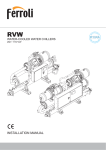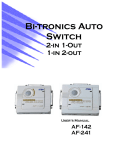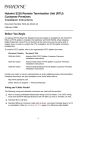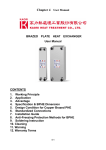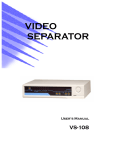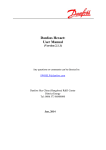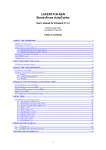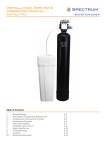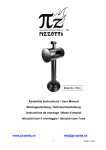Download Trane WSHP-DS-6 User's Manual
Transcript
WSHP-DS-6 WSHP-DS-6 March 2000 Water Source Heat Pump Water-to-Water Model WPWD Introduction The WPWD product is a heating and cooling hydronic fluid water-towater heat pump capable of producing water temperature up to 130 F or temperatures down to 25 F. This extended operating range offers great opportunities in commercial, residential and industrial applications. There are many load side applications for which the WPWD is suited. Typical usages include: q Hydronic baseboard heating In the heating mode, the water-towater unit efficiently extracts heat from a water source (source side) such as a well, lake, boiler/tower loop or closed ground loop heat-exchanger, then transfers the heat to another flow of water (load side). The amount of heat added to the load side is greater than the amount taken from the source side. The electrical energy supplied to the compressor is added to the output heat of compression. q Radiant slab heating q Space heating or cooling with Trane fan coils q Ice and snow removal q High volume water heating (non potable) q Boiler replacement (@130 F) The Trane water-to-water product package includes: q High efficient scroll compressor q Compressor protection q Water to refrigerant condensing coil q Freeze protection q Water to refrigerant evaporator coil q Expansion valve q Filter Drier q Reversing Valve q Internal desuperheater (optional) ©An American Standard Company 2 Table of Contents Introduction 2 Features and Benefits 4 Model Number Description 7 General Data 8 Application Considerations 9 Electrical Data 18 Performance Data 19 Dimensional Data 25 Wiring Diagram 28 Accessory Options 30 Mechanical Specifications 31 3 Features and Benefits General General WPWD cabinet includes full length channel stiffeners underneath the unit. The water source heat pump model WPWD (water-to-water) offers a range of capacities from 2 tons to 6 tons. All units are housed in one standard compact cabinet. Cabinet The cabinet, which allows easy access for installation and service, is constructed of heavy gauge metal. The cabinet finish is produced by a corrosion resistant electrostatic powder paint coating in the color “soft dove”. Heat Exchanger The water to refrigerant heat exchangers are made of stainless steel brazed plate. This design provides a larger amount of surface area for heat exchange between the water and the refrigerant. (See Figure 2 for cut-away). . The top half of the diagonal cabinet is removable for access to the internal components by removing two screws. (See Figure 1). Figure 2: Brazed plate heat exchanger Piping All low-side copper tubing in the refrigeration circuit is insulated to prevent condensation at low entering liquid temperatures. Filter Drier Figure 1: Unit access A filter drier is provided in each unit for dehydration and cleaning of the refrigeration circuit. This feature adds to the unit life. Insulation Expansion Valve To reduce condensation and compressor noise, the cabinets are insulated with 1/2-inch thick, neoprene backed, acoustical fiberglass insulation. As standard, Trane provides a balanced port thermal expansion valve. This valve precisely meters the refrigerant flow through the circuitry to achieve the desired heating or cooling over a wide range of fluid temperatures. Compressor The model WPWD contains a high efficiency scroll compressor for reliable and efficient operation. The scroll compressor’s unique design lends itself to having one of the lowest sound levels in the industry. The compressor is internally isolated and placed on a stiff base plate designed to further reduce vibration noise. As an added benefit, the 4 Water Connections All water connections feature 1-inch brass swivel connectors. Because the connectors are swivel, a back-up wrench is not necessary when tightening. Features and Benefits Controls 24 Volt Controls All electrical controls and safety devices are factory wired, tested, and mounted in the unit. The control package includes: 50 VA Transformer Lockout Relay 24 VAC Contactor q Compressor contactor Ground q 24 Volt transformer q Lockout relay q Compressor run capacitor (1phase units only) Compressor Run Capacitor q Reversing valve coil (For heat pump only) High Voltage Low Voltage q Fuse (for desuperheater) 2 Amp Fuse (for use with desuperheater option) A terminal strip with 1/4” fork connections will be provided for field thermostat control wiring. (See Figure 3). 10 Pole Terminal Strip Safety Devices Each Trane water-to-water unit contains safety devices to prevent compressor damage. These include: q Low pressure switch q High pressure switch q Temperature sensor (freezestat) q Internal overload protection Low Pressure Switch The low pressure switch prevents compressor operation under low charge or in excessive loss of charge situations. This device is set to activate at refrigerant pressures of 35 psig when a 35 F low temperature detection thermostat is applied. An optional 7 psig pressure switch is available when using a 20 F temperature low temperature detection thermostat. Thermostat Low Voltage Low Temperature Detection Thermostat The low water temperature detection thermostat is provided to protect the water-to-refrigerant heat exchanger from freezing. This device prevents compressor operation if leaving water temperature is below 35 F. An optional 20 F temperature thermostat may be applied for low water temperatures where an appropriate antifreeze solution is used. Figure 3: Controls Lockout Relay When the safety controls are activated to prevent compressor short cycling, the lockout relay (circuit) can be reset at the thermostat, or by cycling power to the unit. Thermostat Hook-up Low voltage and high voltage knockouts are provided in the top half of the unit. All control wiring to the unit should be 24 Volt. (See Figure 4 for termination points). High Pressure Switch For internal overload protection, Trane provides a high pressure switch. This de-energizes the compressor when discharge pressure become excessive. 24V Power Compressor Reversing Valve (energized in clg) Figure 4: Typical thermostat termination points 5 Features and Benefits Heat Recovery Desuperheater Option The desuperheater option is a heat recovery system packaged within the water-to-water unit. This option captures heat energy from the heat pump for considerable cost savings all year. Since it is active in either operating mode, it can provide hot water at a reduced cost while in heating or virtually free hot water while in cooling. Standard equipment includes: The unit employs a circulating pump to move water through a double wall heat exchanger. It then returns the heated water to the water tank. This water is heated by superheated refrigerant discharge gas from the compressor. This heat energy can now be utilized as a cost savings in water heating. Circulating Pump The pump is a circular, single stage open system pump. Its specifications include: q 1/25 HP (horsepower) q Desuperheater (heat exchanger) q 230 Volt / 60 Hertz / 1 phase q Circulating pump q 90 Watts q Entering water temperature detector (125 F stops pump) q .40 Amps q Discharge refrigerant temperature detector (145 F starts pump) q Fuse q Water heater hook-up kit q 2865 rpm (revolutions per minute) q 2 MF (microfarad) / 400 Volt capacitor The pump contains a minimum fluid temperature rating of 50 F, a maximum fluid temperature (open system) of 140 F, and a maximum working pressure of 145 psi. Hot water (Supply) Isolation Valves (by others) from Desuperheater to Desuperheater Desuper-out Desuper-in Water heater hook-up kit with drain valve 6 Cold water (Supply) Model Number Description 1 5 10 15 Digit 11: Freeze Protection (source side) 1 = Brazed Plate Heat Exchanger with 35 F (1.67 C) Freezestat 2 = Brazed Plate Heat Exchanger with 20 F (-6.67 C) Freezestat Digits 1 & 2: Product Type WP = Trane Commercial Water Source Heat Pump Digit 3: Product Configuration W = Water-to-Water Digit 4: Development Sequence D Digit 12: Freeze Protection (load side) 1 = Brazed Plate Heat Exchanger with 35 F (1.67 C) Freezestat 2 = Brazed Plate Heat Exchanger with 20 F (-6.67 C) Freezestat Digits 5-7: Unit Nominal Capacity 024 = 24.0 MBh 036 = 36.0 MBh 042 = 42.0 MBh 048 = 48.0 MBh 060 = 60.0 MBh 072 = 72.0 MBh Digit 13: Desuperheater Option 0 = No Desuperheater 1 = With Desuperheater Digit 14: Open 0 = Open Digit Digit 8: Voltage / Hertz / Phase 1 = 208-230/60/1 3 = 208-230/60/3 4 = 460/60/3 5 = 575/60/3 6 = 220-240/50/1 7 = 265/60/1 9 = 380-415/50/3 Digit 15: Open 0 = Open Digit Digit 16: Sticker Option T = Trane C = Command-Aire Digit 9: Unit Arrangement 0 = Water-to-Water Digit 10: Design Sequence C 7 General Data Table G-1: Physical Data (English) Model: WPWD Width of cabinet (in) 024 036 042 048 060 072 23 23 23 23 23 23 Width of cabinet and connections (in) 24.8 24.8 24.8 24.8 24.8 24.8 Height (in) 24.3 24.3 24.3 24.3 24.3 24.3 Depth (in) 23.3 23.3 23.3 23.3 23.3 23.3 Compressor R-22 Type Refrigerant (lbs) Scroll 3.25 Scroll 3.375 Scroll 3.50 Scroll 4.00 Scroll 4.25 Scroll 4.25 Approximate Weight (lbs) With crate (lbs) 163 183 203 214 244 277 Unit Size Table G-2: Specifications (English) Model: WPWD 024 036 042 048 060 072 Source and Load GPM 4.0 6.0 7.0 7.50 10 10 Source and Load Ft. Hd. 1.4 3.2 4.4 5.0 9.2 9.2 Cooling Load EWT 45 F (MBH) 18.24 26.74 31.3 35.55 45.98 51.01 Cooling Heating Load EWT 45 F (EER) Load EWT 100 F (MBH) 15.0 25.38 15.7 33.34 15.7 39.69 15.4 42.87 15.5 57.15 14.9 67.47 Heating Load EWT 100 F (COP) 3.64 3.62 3.7 3.45 3.62 3.62 Note: q Source EWT (entering water temperature) is at 75 F q Unit selection should be based upon extended specifications at lowest or highest expected source and load EWT (entering water temperature) q Refer to pages 19-25 for extended performance tables. 8 Application Considerations Closed Loop System Closed loop systems (both ground source and surface water) provide heat rejection and heat addition to maintain proper water source temperatures. Operating and maintenace cost are low because an auxillary fossil fuel boiler and cooling tower are not required to maintain the loop temperature. The technology has advanced to the point where many electric utilities and rural electric cooperatives are offering incentives for the installation of geothermal systems. These incentives are offered because of savings to the utilities due to reduced peak loads that flatten out the system demand curve over time. For ground source geothermal systems, (See Figure 5), when building cooling Figure 5: Ground source geothermal system requirements cause loop water temperatures to rise, heat is dissapated into the cooler earth through buried polyethylene pipe heat exchangers. If reversed, heating demands cause the loop temperature to fall, enabling the earth to add heat to meet load requirements. Where local building codes require water retention ponds for short term storage of surface run-off, a ground source surface water system, (See Figure 6), can be very cost effective. This system has all the advantages as the geothermal system in cooling dominated structures. Another benefit of the ground source system is that it is environmentally friendly. The loop is made of chemically inert, non-polluting polyethylene pipe. The heat pumps use HCFC-22 refrigerant, which has a lower ozone depletion potential than CFC-12. Because the closed loop system does not require a heat adder, there are no CO2 emissions. Less electric power consumed reduces secondary emissions from the power plant. Therefore, the system offers advantages not seen by other central furnace or heat pump systems. Figure 6: Ground source surface water system 9 Application Considerations Open Loop System Where an existing or proposed well can provide an ample supply of suitable quality water, ground water systems may be very efficient. (See Figure 7) Operation and benefits are similar to those for closed loop systems. There are however several considerations that should be addressed prior to installation. q An acceptable way to discharge the significant volume of used water from the heat pump should be defined. It may be necessary to install a recharge well to return the water to the aquifer. q Water quality must be acceptable, with minimal suspended solids. To help ensure clean water, a straining device may be required. Figure 7: Open Loop system Cooling Tower/Boiler System A cooling tower/boiler system (see Figure 8) utilizes a closed heat recovery loop along with multiple water source heat pumps in a more conventional manner. Typically, a boiler is employed to maintain closed loop temperatures above 60 F and a cooling tower to maintain closed loop temperature below 90 F. All the units function independantly, either by adding heat, or removing heat from the closed water loop, making this system more efficient than air cooled systems. The cooling tower/boiler system provides a low installation cost to the owner than other systems. A good selection for large building design needs. Figure 8: Cooling tower/boiler system 10 Application Considerations Source Side vs. Load Side Source vs. Load source side heat exchanger to the load side heat exchanger. The model WPWD water-to-water system contains two water to refrigerant heat exchangers. The two heat exchangers enable the system to be divided into a source and load separation. The “load side” heat exchanger takes the place of a DX (direct expansion) air coil. It provides treated fluid (hot or cold) to a mechanical device. These mechanical devices include designs such as radiant slab heating, hydronic coils, or fresh air ventilation units. The “source side” heat exchanger performs as in a standard water to air heat pump system. The source is typically supplied through a cooling tower, boiler, closed loop, or open well system. During the refrigeration cycle, heat is transferred from the See Figure 9 for a basic schematic of source side verses load side of a water-to-water system. Water-In (Load Side) Fluid traveling TO or FROM a mechanical device such as hydronic coil, concrete slab, or flooring Water-In (Source Side) Refrigeration Circuit Fluid traveling TO or FROM a cooling tower, boiler, ground loop or open well system Water-Out (Source Side) Water-Out (Load Side) Figure 9: Source/Load schematic 11 Application Considerations Closed Loop Geothermal Hydronic Ice Melting Via a Water-to-Water Unit Geothermal Space Temperature Heating / Cooling Refrigeration Equipment (Closed) Ground Loop Heat Exchanger Geothermal Integrated System The Trane ground source heat pump is highly efficient in service station applications. This integrated system design takes advantage of the earths relatively constant temperature (45 F to 70 F) to space condition the building. In addition, appliances such as freezers, ice makers and a display coolers may be added to the loop for further gains in the reduction of consumed energy. Cold climates may take an even greater advantage of the heat rejected by the stores refrigeration equipment and space conditioning heat pumps. This rejected heat may be used by Trane’s water-towater heat pump(s) to heat water for a car wash and melt ice off of a driveway (allowing the car wash to remain open all winter). This integrated system also eliminates thermal short circuiting between the intakes and the exhausts of an air cooled refrigeration system. 12 Typical Benefits q Annual energy savings means lower operational costs q Takes advantage of the earths constant temperature rather than high fluctuation of ambient temperature q Heat energy rejected from the space conditioner can be utilized for ice or snow melting of a parking lot in colder climates q Two to three year estimated payback on installation costs Application Considerations Fresh Air Ventilation Water-Out (source) Fresh Air Ventilation with Water-to-Water Units Water-Out (load) Water-In (source) Water-In (load) Exhaust Air Fresh Air Geothermal Space Heating and Cooling (Closed) Ground Loop Heat Exchanger Water-to-Water and Fresh Air Ventilation Geothermal energy systems take advantage of the fact that subsurface earth temperatures are constant year-round, which makes the earth an ideal heat source and heat sink for heat pumps. The above design goes further than just space heating and cooling. Fresh air ventilation is achieved by using Trane water-to-water units teamed with a hydronic outside air unit, and exhaust air unit to meet total building requirements. In the cooling season, the evaporator water from the heat pumps is circulated through a hydronic coil in the makeup air unit to provide cooling and dehumidification. The condenser water is used to provide reheat energy to temper the ventilated air in accordance with the building needs. After leaving the reheat hydronic coil, the condenser water is then returned to the building loop for further heat rejection. In heating, the water-to-water units switch to hot water generation. The water for ventilation air tempering first circulates through the hydronic coil to the exhaust air unit to pick up heat from the building exhaust airstream. The water then circulates through the water-towater heat pumps for further heat introduction before being used by 13 the makeup air unit hydronic coil to heat the makeup air to maintain building requirements. This ventilation system incorporates its own constant volume pumps to pull system water off the loop and return it. There is no need for additional heat injection using boilers for this system. (See Page 14 for mechanical example). Typical Benefits q Annual energy savings means lower energy costs q Building comfort and climate control Application Considerations EXHAUST AIR Fresh Air Ventilation Mechanical OUTSIDE AIR HOT WATER COIL AIR HANDLER EXHAUST AIR TO HEAT PUMPS EXHAUST AIR FROM TOILET RMS AIR HANDLER EXP TANK AUTOMATIC AIR VENT HAND PUMP WPWD WPWD WPWD WPWD BALL VA SUPPLY RETURN 14 DRAIN VA PRESSURE RELIEF VA Application Considerations Central Pumping System 6 7 1 5 2 4 General A central pumping system involves a single pump design usually located within a basement or mechanical room to fulfill pumping requirements for the entire building system. With a central pumping system, an auxiliary pump is typically applied to lessen the likelihood of system down-time if the main pump malfunctions. (See Figure 10 for unit installation of a central pumping system). 3 Figure 10: Central pumping system installation minal devices with 45 F or Central Pump 120 F fluid. Application The sound attenuation pad should be slightly oversized for Ball valves should be installed unit. This field supplied product in the supply and return lines is recommended for sound for unit isolation and unit water absorption of unit. flow rate balancing (if an automatic flow device is not The low voltage control conselected). This connection, nection provided on the unit is along with hoses, are also reclarge enough for attaching conommended for backflushing duit. and chemical cleaning of the The central systems supply water to refrigerant heat and return lines should be exchanger. sized to handle the required Flexible hoses may be used flow with a minimum pressure to connect the water supply drop. and return lines to the water Note: Pipe will sweat if low inlets and outlets. These hoses temperature water is run reduce possible vibration through the supply or return between the unit and the rigid lines. Trane recommends that system. these lines be insulated to prevent damage from condensaNote: Hoses and or pipes tion. should be made of braided The field supplied line voltage stainless steel, and sized suitdisconnect should be ably for the systems water installed for branch circuit propressure and flow rate. tection. The unit is supplied Load side connections are with an opening for attaching typically used to supply the terconduit. Application Considerations Well Water Systems 7 6 Ov ow erfl turn Re y ppl Su 5 9 8 1 3 4 General A well water application involves an open loop water supply. The water is drawn from an open well or pond into the unit. A straining device is required with this application. Similar to the closed loop design, an open water supply usually remains at a constant temperature year round utilizing maximum efficiency in unit design. 2 Figure 11: Well water installation Well Water Application See Figure 11 for open well water installation. Ball valves should be installed in the supply and return lines for unit isolation and unit water flow rate balancing (if automatic flow device is not selected). This connection, along with hoses, are also recommended for backflushing and chemical cleaning of the evaporator and the condenser. Flexible hoses may be used to connect the water supply and return lines to the water inlets and outlets. These hoses reduce possible vibration between the unit and the rigid system. Note: Hoses and or pipes should be braided stainless steel, and sized suitable for the system’s water pressure and flow rate. Load side connections are used to supply the terminal device. 16 The sound attenuation pad should be slightly oversized for the unit. This field supplied product is recommended for sound absorption of unit. The low voltage control connection provided on the unit is large enough for attaching conduit. The expansion tank should be sized to maintain pressure on the system. The line voltage disconnect should be installed for branch circuit protection. The unit is supplied with an opening for attaching conduit. The water regulating valve assembly is used to maintain refrigerant pressure in refrigerant circuit as the entering water temperature varies or is cooler than ideal. Schrader connections are factory installed for ease of attaching the water regulating valve assembly. Application Considerations Distributed Pumping System 8 7 6 1 5 2 4 General A distributed pumping system contains either a single or dual pump module connected directly to the units supply and return source side. This design requires individual pump modules specifically sized for each water source heat pump. Centralized pumping is not required. 3 Figure 12: Distibuted pumping installation Earth Coupled Application See Figure 12 for a distributed pumping installation. Ball valves should be installed in the supply and return lines for unit isolation. Flexible hoses may be used to connect the water supply and return lines to the water inlets and outlets. These hoses reduce possible vibration between the unit and the rigid system. Note: Hoses and or pipes should be braided stainless steel, and sized suitable for the system’s water pressure and flow rate. Load side connections are used to supply the terminal device. 17 The sound attenuation pad should be slightly oversized for the unit. This field supplied product is recommended for sound absorption of unit. The low voltage control connection provided on the unit is large enough for attaching conduit. The ground loop pump module is designed for circulating commercial loops that require a maximum flow rate of 20 gpm. The line voltage disconnect should be installed for branch circuit protection. The unit is supplied with an opening for attaching conduit. All polyethene pipe in the closed loop design should be insulated to eliminate the risk of sweating. Electrical Data Table E-1: Electrical Data 024 036 Compressor RLA 11.4 15 18.4 Compressor LRA 56 73 95 Minimum Circuit Ampacity 16 21 Max Fuse Size Aux Pump Amps 25 2.5 30 2.5 Desuperheater Min Cir Ampacity 14.3 Desuperheater Pump RLA 0.4 Model: WPWD 060 072 20.4 28 32.1 109 169 169 25.8 28.6 39 45 40 2.5 45 2.5 60 2.5 70 2.5 18.8 23 25.5 35 40.1 0.4 0.4 0.4 0.4 0.4 Voltage 042 048 208-230/60hz/1phase Voltage Compressor RLA 208-230/60hz/3phase 11.4 13.9 - 10.7 20 19.3 Compressor LRA - 63 77 88 123 137 Minimum Circuit Ampacity Max Fuse Size - 15 20 16 25 19.4 30 28 45 27 40 Aux Pump Amps - 2.5 2.5 2.5 2.5 2.5 Desuperheater Min Cir Ampacity - 13.4 14.3 17.4 25 24.1 Desuperheater Pump RLA Voltage - 0.4 0.4 0.4 Compressor RLA - 5 5.7 7.1 7.5 10 Compressor LRA - 31 39 44 49.5 62 Minimum Circuit Ampacity Max Fuse Size - 7 15 8 15 10 15 10.5 15 14 20 Aux Pump Amps - 2.5 2.5 2.5 2.5 2.5 Desuperheater Min Cir Ampacity - 6.3 7.1 8.9 9.4 12.5 Desuperheater Pump RLA Voltage - 0.4 0.4 0.4 Compressor RLA - - - - 6.4 7.8 Compressor LRA - - - - 40 50 Minimum Circuit Ampacity Max Fuse Size - - - - 9 15 11 15 Aux Pump Amps Desuperheater Min Cir Ampacity - - - - 2.5 8 2.5 9.8 Desuperheater Pump RLA Voltage - - 0.4 0.4 Compressor RLA 9.6 14.3 16.4 17.1 - - Compressor LRA 47 71 83 98 - - Minimum Circuit Ampacity Max Fuse Size 13.5 20 20 30 23 35 24 35 - - Aux Pump Amps 2.5 2.5 2.5 2.5 - - Desuperheater Min Cir Ampacity 12 17.9 20.5 21.4 - - Desuperheater Pump RLA 0.4 0.4 0.4 0.4 - - 0.4 0.4 460/60hz/3phase 0.4 0.4 575/60hz/3phase 265/60hz/1phase 18



















